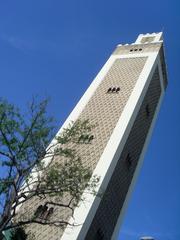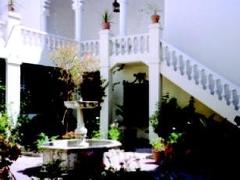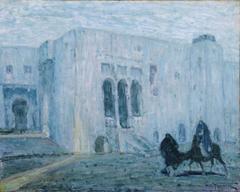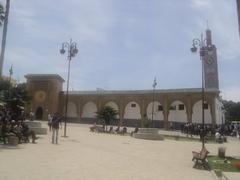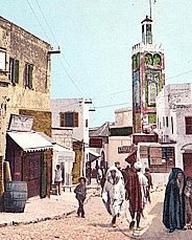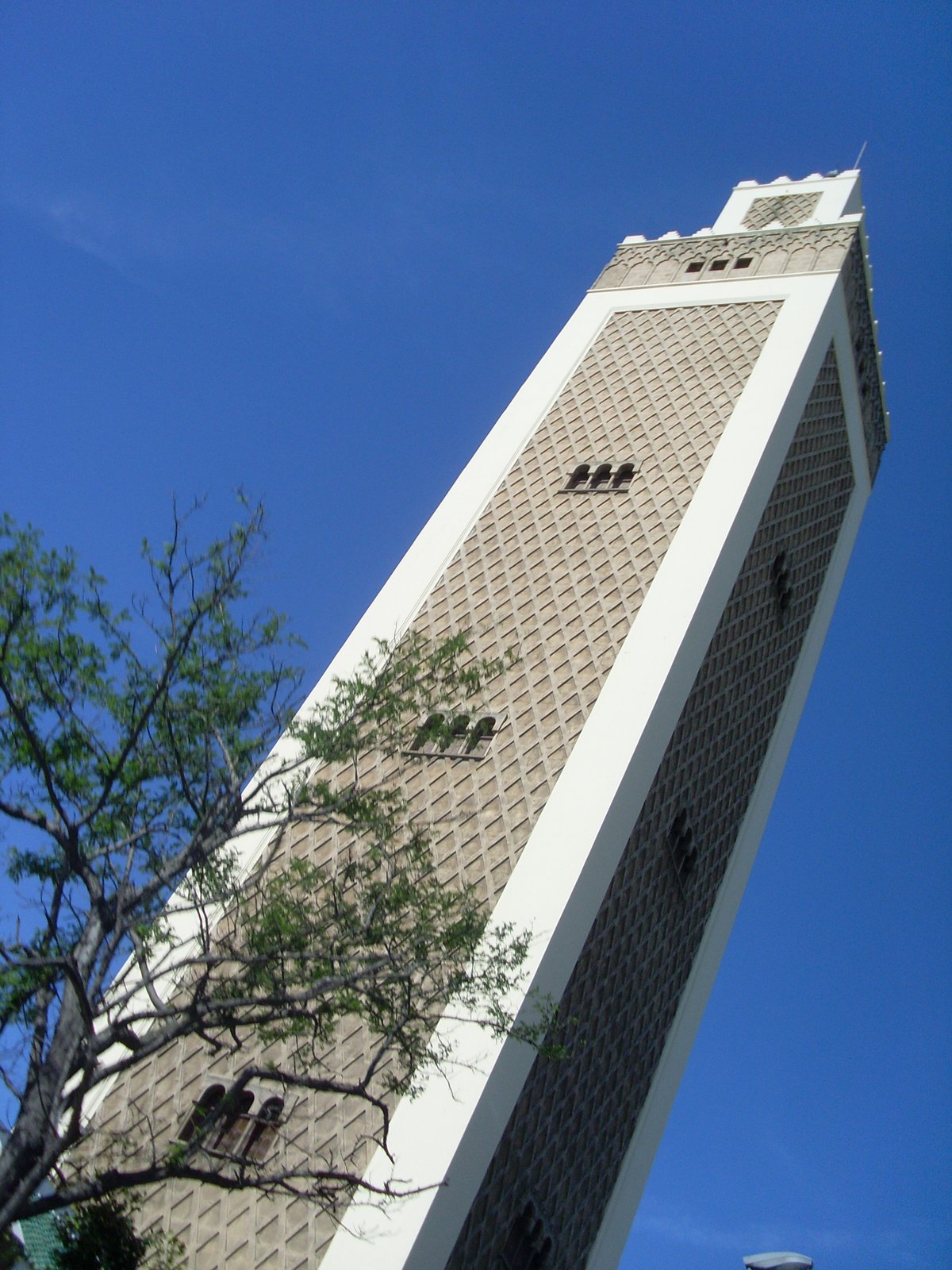
Mohammed V Mosque Tangier: Visiting Hours, Tickets, and Comprehensive Guide
Date: 15/06/2025
Introduction
The Mohammed V Mosque in Tangier stands as a majestic testament to Morocco’s Islamic heritage, architectural beauty, and the city’s layered history. Built in the late 20th century to honor King Mohammed V—widely recognized as the “Father of Moroccan Independence”—the mosque is both a spiritual sanctuary and a vibrant cultural hub. Its soaring minaret, the tallest in Tangier, intricate zellij tilework, and peaceful courtyards draw visitors from around the globe. While access to the prayer hall is reserved for Muslim worshippers, the mosque’s exterior and surrounding grounds remain open to all, providing a unique glimpse into Morocco’s religious and architectural traditions.
This guide offers a detailed exploration of the mosque’s historical context, cultural significance, architectural highlights, practical visitor information (including hours, tickets, accessibility, and etiquette), and tips for making the most of your visit. For additional resources and travel planning, see The Mystery Traveler, Journal of Nomads, and the Moroccan National Tourist Office.
Table of Contents
- Introduction
- Historical Background
- Symbolism and Cultural Role
- Visiting the Mosque
- Frequently Asked Questions (FAQ)
- Summary and Visitor Tips
- Sources and Further Reading
Historical Background
Construction and Dedication
Completed in 1983, the Mohammed V Mosque was initiated by then Crown Prince Mohammed (now King Mohammed VI), with financial backing from Kuwait. The mosque’s creation is tied to a symbolic moment: a Kuwaiti sheikh reportedly chose to fund the mosque after noticing that a nearby Catholic Cathedral’s bell tower dominated Tangier’s skyline. The resulting minaret of the mosque was deliberately designed to surpass it, reinforcing the presence of Islamic tradition (The Mystery Traveler).
Mohammed V’s Legacy
King Mohammed V played a pivotal role in Morocco’s independence. His 1947 speech in the Mendoubia Gardens of Tangier was a defining call for sovereignty and unity. The mosque, bearing his name and occupying a prominent location, commemorates his leadership and vision for a unified Moroccan identity.
Architectural Evolution
As the largest mosque in Tangier, the Mohammed V Mosque merges classical Moroccan and Islamic styles with modern techniques. The complex encompasses:
- The city’s tallest minaret, a visual landmark
- The regional Ulama council, theological institute, and boarding school
- Offices for the Ministry of Habous & Islamic Affairs
- A public library
This multifaceted role underscores the mosque’s function as both a religious and educational center (The Mystery Traveler).
Symbolism and Cultural Role
National and Religious Identity
Built in the post-independence era, the mosque visually and culturally asserts Morocco’s Islamic heritage and national pride. Its prominent minaret and architectural elegance reflect centuries of Moroccan artistry and serve as symbols of faith and unity.
Community and Educational Functions
The mosque complex houses a theological institute and boarding school, supporting religious education and community events. It is a focal point for festivals, public gatherings, and religious life in Tangier.
Interfaith and Urban Impact
The mosque’s minaret, taller than the adjacent cathedral’s bell tower, encapsulates Tangier’s history as a crossroads of cultures and religions. While the prayer hall is reserved for Muslims, the openness of the mosque’s grounds fosters cultural exchange and reflects the city’s spirit of tolerance (Journal of Nomads).
Visiting the Mosque
Opening Hours and Entry
- General hours: 9:00 AM – 6:00 PM daily. Hours may vary during religious holidays.
- Prayer hall: Entry permitted to Muslims only.
- Exterior and grounds: Open to all visitors; no entrance fee.
Tip: Early morning or late afternoon visits provide the best lighting for photography and a more peaceful ambiance.
Accessibility and Dress Code
- The mosque is accessible via ramps and wide pathways.
- Modest dress is essential: cover shoulders and knees; women should carry a scarf.
- Shoes must be removed if entering any designated interior spaces.
Guided Tours and Events
- Guided tours may be available through local operators or cultural centers; inquire in advance.
- The mosque occasionally hosts religious festivals and public events, offering unique cultural experiences.
Photography and Visitor Etiquette
- Photography is allowed in exterior areas but should be discreet and respectful.
- Avoid photographing worshippers without permission; interior photography is generally prohibited.
- Maintain a quiet, respectful demeanor; refrain from eating, drinking, or smoking near the mosque.
Nearby Attractions
- Mendoubia Gardens: Historic park where King Mohammed V delivered his independence speech.
- Kasbah Museum: Exhibits on Moroccan history and culture.
- Place du Koweit: Commemorative square adjacent to the mosque.
- American Legation Museum: The oldest U.S. diplomatic property abroad.
- Vibrant Medina: Explore traditional markets, artisan shops, and cafes.
Frequently Asked Questions (FAQ)
Q: Can non-Muslims enter the Mohammed V Mosque?
A: Non-Muslims may visit the mosque’s exterior and courtyards, but access to the prayer hall is reserved for Muslims.
Q: What are the mosque’s visiting hours?
A: Generally open 9:00 AM – 6:00 PM daily; check locally for changes during holidays.
Q: Is there an entrance fee?
A: No fee is required to visit the grounds; guided tours may have a cost.
Q: Are guided tours available?
A: Yes, through local tour operators or cultural organizations.
Q: What is the dress code?
A: Modest clothing covering arms and legs; women should carry a scarf.
Q: Is the mosque accessible for those with disabilities?
A: Yes, ramps and accessible entryways are provided.
Q: Is photography allowed?
A: Yes, in exterior areas; seek permission for photos of people or during events.
Summary and Visitor Tips
The Mohammed V Mosque is a vital symbol of Tangier’s spiritual, cultural, and architectural heritage. Its design, history, and educational role make it a cornerstone of the city’s identity. Visitors are encouraged to:
- Respect religious customs and local etiquette
- Dress modestly and behave respectfully
- Visit nearby attractions to deepen their understanding of Tangier’s history
- Use resources like The Mystery Traveler, Journal of Nomads, and the Tangier Tourism Board for additional planning.
For a richer experience, take advantage of local guided tours, and don’t miss the opportunity to explore Tangier’s vibrant medina, museums, and scenic viewpoints.
Sources and Further Reading
- Visiting the Mohammed V Mosque in Tangier: History, Significance, and Visitor Information, 2025 (Audiala)
- Visiting the Mohammed V Mosque in Tangier: History, Tickets, and Travel Tips, 2025 (The Mystery Traveler)
- Visiting Mohammed V Mosque in Tangier: Hours, Tickets, Architectural Highlights, and Visitor Guide, 2025 (Audiala)
- Visiting the Mohammed V Mosque in Tangier: Hours, Etiquette, and Travel Tips, 2025 (Audiala)
- Things to Do in Tangier Morocco, 2025 (Journal of Nomads)
- Moroccan National Tourist Office, 2025
- Tangier Tourism Board, 2025
